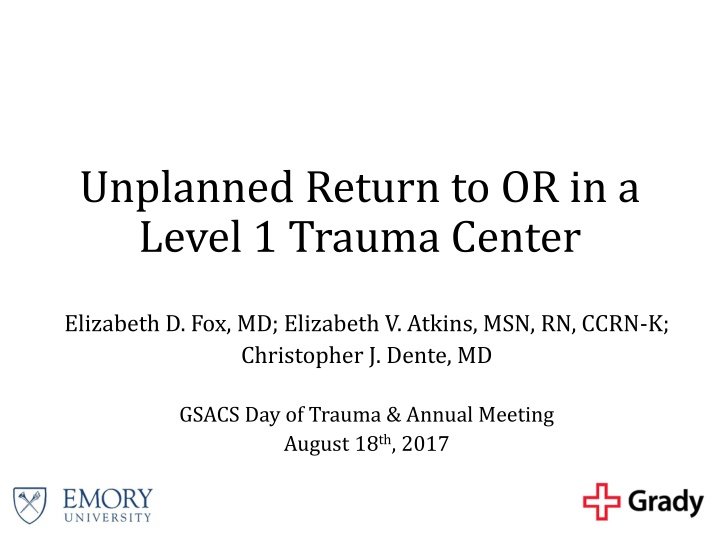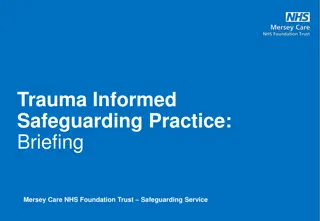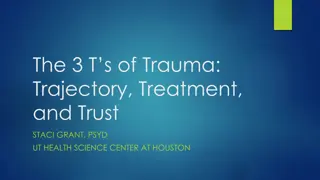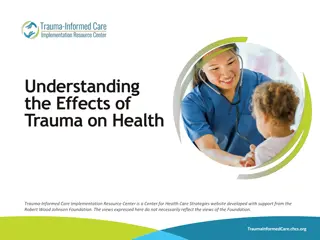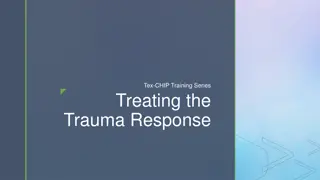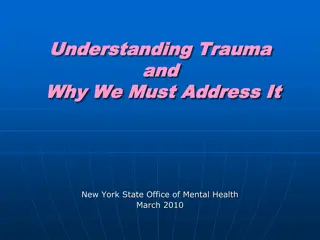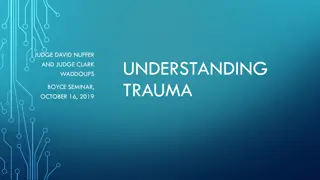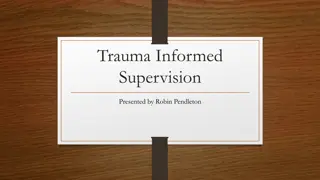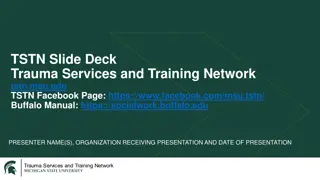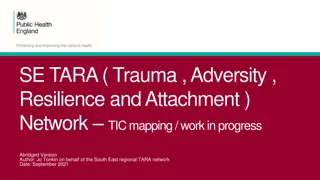Factors Associated with Unplanned Return to OR Among Trauma Patients
Retrospective analysis of trauma patients at Grady Memorial Hospital reveals factors contributing to unplanned return to the Operating Room (OR). The study aims to identify patient-related characteristics, mechanisms of trauma, injuries sustained, and outcomes such as ventilator days, ICU stay, and complications. Strategies for preventing unplanned returns are discussed based on the analysis results.
Download Presentation

Please find below an Image/Link to download the presentation.
The content on the website is provided AS IS for your information and personal use only. It may not be sold, licensed, or shared on other websites without obtaining consent from the author.If you encounter any issues during the download, it is possible that the publisher has removed the file from their server.
You are allowed to download the files provided on this website for personal or commercial use, subject to the condition that they are used lawfully. All files are the property of their respective owners.
The content on the website is provided AS IS for your information and personal use only. It may not be sold, licensed, or shared on other websites without obtaining consent from the author.
E N D
Presentation Transcript
Unplanned Return to OR in a Level 1 Trauma Center Elizabeth D. Fox, MD; Elizabeth V. Atkins, MSN, RN, CCRN-K; Christopher J. Dente, MD GSACS Day of Trauma & Annual Meeting August 18th, 2017
Definition Unplanned return to the Operating Room after initial operative management for a similar or related procedure
Unplanned return to OR Several studies in Neurosurgery, Orthopaedic, and General Surgery patients, but overall literature is limited oApproximately 3% of operations (0.5-10%) oAssociated with patient comorbidities, acuity of operation, type of operation, technical aspects1 Pujol N et al. 2015 1Lin Y et al. Am J Surg. 2016; S0002-9610(16)30956-4
Unplanned return to OR among trauma patients There are no studies looking specifically at unplanned return to OR among trauma patients.
Unplanned return to OR among trauma patients There are no studies looking specifically at unplanned return to OR among trauma patients. Questions: oWhat factors are associated with unplanned return to OR among trauma patients? oWhat can be done to prevent this event?
Methods Retrospective analysis of data from Grady Memorial Hospital Trauma Registry Patients admitted after trauma January 1st, 2016 March 31st, 2017 Charts were reviewed for o Patient factors (age, gender, comorbidities, mechanism of trauma, ISS, injuries sustained) o Specifics of all operative interventions o Outcomes (ventilator days, ICU LOS, hospital LOS, complications, mortality)
Methods Definition of Unplanned return to OR (UROR) group Unplanned return to the Operating Room after initial operative management for a similar or related procedure
Methods Patients were identified as Not truly unplanned if oThe return was, in fact, planned oThe return was for anesthesia support for a non- operative procedure (i.e. ERCP) oThe return was unrelated to a previous operation oThe operation was related to a previous comorbidity (i.e. AVR in aortic stenosis patient), not part of trauma management
Overall numbers 1/1/2016 3/31/2017 Patients identified from Trauma Registry 86 Not truly unplanned 10 True UROR Unplanned returns 76 82
Not truly unplanned Return was planned o Washout/debridement after fasciotomy, n = 2 o Washout/debridement after I&D, n = 1 o Definitive fixations after ex-fix, n = 1 Return was for anesthesia support o ERCP for bile leak or pancreatic leak, n = 2 o Tracheostomy exchange, n = 1 Return was unrelated to previous operation o Bronchoscopy after imaging, n = 1 o ORIF of different extremity fracture, n = 1 Original operation was for a previous comorbidity o Bleed after AVR, n = 1
Not truly unplanned: Documentation Planned reoperation was the most common reason for return to OR, but plan was not always explicit in the operative note o Ex-fix to remain in place oFor both fasciotomy cases, no indication in op note that further washout/closure would be required One patient underwent planned postoperative radiographic workup, but this plan was not noted in the original operative note
True unplanned return to OR: Patient characteristics Variable Age (mean) Male gender Comorbidities Obesity Coronary artery disease Diabetes HIV/AIDS Anticoagulant/antiplatelet use Blunt trauma ISS (mean) True Unplanned (n=76) 39 years 84% (n = 64) 9% (n = 7) 7% (n = 5) 7% (n = 5) 2.6% (n = 2) 7% (n = 5) 51% (n = 39) 22.4
True unplanned return to OR: Services Service Number of cases (n=82) 65% (n = 53) 13% (n = 11) 9.8% (n = 8) 4.9% (n = 4) 2.4% (n =2) 1.2% (n = 1) 1.2% (n = 1) 1.2% (n = 1) 1.2% (n = 1) Trauma Surgery Orthopaedic Surgery Neurosurgery Vascular Surgery Neurosurgery (Spine) Orthopaedics (Hand) PRS (Face) OMFS (Face) PRS (Hand)
Overall outcomes True UROR (n = 76 patients) Outcome Ventilator days 7.3 days ICU LOS 13.1 days Hospital LOS 27 days Mortality 13.2% (10/76 patients) 28.8% (19/66 patients) Discharge to rehab or longterm care facility
Reasons for unplanned return to OR Site Reason # cases Service for Index Case Cranial Hematoma VP shunt malfunction Wound infection Hydrocephalus Bleed s/p tracheostomy Missed vascular injury Submental hematoma Anastomotic leak Failed percutaneous tracheostomy Missed vascular injury Empyema Retained hemothorax Thrombosed vascular repair 3 1 1 1 3 1 1 2 1 1 2 2 1 Neurosurgery Neurosurgery Neurosurgery Neurosurgery Trauma Surgery Trauma Surgery PRS (Face) Trauma Surgery Trauma Surgery Trauma Surgery Trauma Surgery Trauma Surgery Vascular Surgery Neck Thorax
Reasons for unplanned return to OR Site Abdomen Reason Hemorrhage Missed injury Evisceration Ureteral injury Compartment syndrome Graft infection Dislodged or malpositioned PEG Anastomotic leak Evacuation of hematoma Wound dehiscence Compartment syndrome Wound infection Hardware infection Hardware malposition Missed vascular injury Necrosis Pseudoaneurysm Epidural hematoma # cases 4 3 3 2 2 1 3 1 1 4 3 3 2 1 2 1 1 2 Service for Index Case Trauma Surgery Trauma Surgery Trauma Surgery Trauma Surgery Trauma Surgery Trauma Surgery Trauma Surgery Trauma Surgery Trauma Surgery Orthopaedics, Trauma Surgery Orthopaedics, Trauma Surgery PRS (Hand), Trauma, Orthopaedics Orthopaedics Orthopaedics Trauma Surgery Orthopaedics (Hand) Vascular Surgery Neurosurgery Spine Extremity Spine
Most common reasons for unplanned return to OR Characteristic Bleeding Event (n=21) 36.9 years 91% 52% 25.1 10% Surgical Site Event (n=20) 41.8 years 67% 60% 19.3 0% Missed Injury (n=11) 38.3 years 82% 27% 25.2 0% Age Male gender Blunt mechanism ISS Anti-coagulant/ anti-platelet Emergent OR? Hospital LOS Ventilator days ICU LOS Mortality 76% (n = 16) 33.6 days 10.1 days 17.3 days 9.5% (n = 2) 60% (n = 12) 28.8 days 8.8 days 13.6 days 5% (n = 1) 100% (n = 12) 26.7 days 4.8 days 10.7 days 9.1% (n =1)
Further analysis: Emergent Operation Initial operation was emergent in 72% of patients (n = 57) Emergent defined as ED Dispo to Operating Room This group may be at higher risk of unplanned return to OR given hemodynamic instability and/or limited initial diagnostic workup
Emergent Operation (ED to OR) Characteristic No UROR (n = 1315) 37.6 years 78% (n = 1030) 39% (n = 511) 14 2.1 days 4 days 11.5 days 5.6% (n = 74) True UROR (n = 57) 37.3 years 84% (n = 48) 65% (n = 37) 24.6 7.6 days 13.2 days 25.9 days 14% (n = 8) p value Age Male gender Penetrating injury ISS Ventilator days ICU LOS Hospital LOS Mortality 0.85 0.32 0.001 <0.0001 <0.0001 <0.0001 <0.0001 0.0172
Unplanned return to OR Summary Improved documentation of plan for return to OR may improve accuracy of detecting unplanned return to OR The most common reasons for unplanned return to OR were o bleeding events (24%) o surgical site complications (dehiscence and infection; 23%) o missed injury (13%) There were no unplanned return to OR events for unintended retained surgical item or hardware failure
Unplanned return to OR Summary Initial operation was emergent in the vast majority of patients who had UROR for bleeding events and missed injury Among patients requiring emergent operation, UROR was associated with more severe injury and higher rates of penetrating injury oUROR affects outcomes, with UROR patients having longer hospitalization and higher mortality rates
Unplanned return to OR Future directions Evaluation of complications among unplanned return to OR patients Further comparison of outcomes versus patients who did not have unplanned returns to OR Track service-specific occurrences and outcomes State-wide review of unplanned returns to OR
Unplanned Return to OR in a Level 1 Trauma Center Elizabeth D. Fox, MD; Elizabeth V. Atkins, MSN, RN, CCRN-K; Christopher J. Dente, MD GSACS Day of Trauma & Annual Meeting August 18th, 2017
